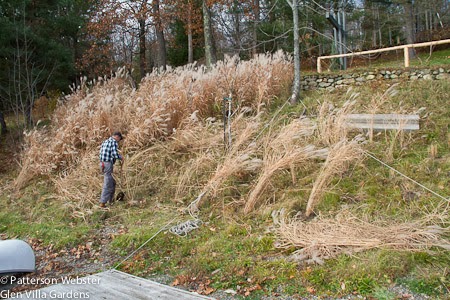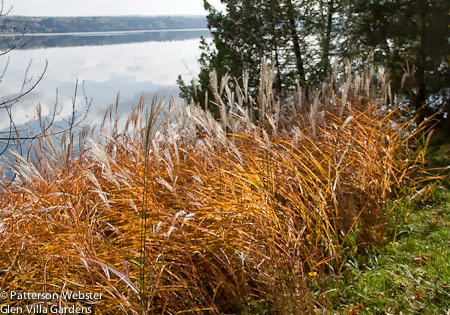I’ve been using ornamental grasses for about ten years now, and I’ve used them in various parts of the garden, including at the aqueduct, which I wrote about last week. One of the first places I put them was on the hill that slopes down to the lake. The plants, ordinary miscanthus sinensis, were a reasonable size when I planted them; now the small clump has grown to cover a large area, as I’ve divided and spread them out several times.
 |
| Dividing miscanthus — a hard day’s work. |
Environmental regulations mean we can’t mow the hillside, so the miscanthus is a godsend. They are nothing special In June and July but in August they begin to come into their own. By September they have turned colour, from an acceptable-but-nothing-special shade of green to an intense yellowy-orange that really stands out against the dark evergreens behind. On a seemingly windless day, when no ripples appear on the surface of the water, their feathery white tufts still move gently in the breeze.
|
|
|
Miscanthus sinensis: almost as good as a pot of gold
|
Their flowers persist through the winter, sticking up above the snow if it isn’t too deep. And on a winter day, even a drop of moisture on the inflorescence catches the sun.(Here I was planning to insert a photo showing that drop of water glistening in the sunlight. Alas, after my external hard drive crashed, destroying several thousand photos, I cannot. ((Commiserations, please.)) So you’ll have to use your imagination.)
In the upper field by the skating pond, I’ve used two other types of miscanthus. The first I added was Miscanthus sinensis ‘Malepartus.’ Originally I saw it at a nursery in August, when it was beginning to show its distinctive deep red colouring. Now that it is a few years older, that colour is even more intense, both on the stems and on the inflorescence.
 |
Miscanthus ‘Malepartus’ sounds evil but looks nice.
Can anyone explain its strange varietal name? |
Near the ‘Malepartus’ is miscanthus sinensis ‘Morning Light.’ Backlit, the feathery tufts of this cultivar are longer and whiter than the ordinary miscanthus by the lake. If I could start this planting again, I’d use one or the other of these two cultivars, not both. But which one? I like the whiter inflorescence of ‘Morning Light’ and the deep red of ‘Malepartus.’ So, both varieties remain. (Laziness may have something to do with that as well. It’s hard work moving these tough grasses.)
|
|
|
‘Morning Light’ is my favourite miscanthus in autumn because of the whiteness of the tufts.
|
Of all the ornamental grasses I’ve used, though, my favourite by a long shot is Korean feather reed grass, calamagrostis ‘Karl Foerster.’ I love how the colour changes throughout the summer, from June…
 |
| Karl’s red top provides a strong colour in late June |
to July…
 |
| a tawny tuft contrasts with green foliage in July |
to September….
 |
| Tufts turn the colour of honey in September |
to mid-October.
 |
| Tufts turn the colour of oats in October. |
Karl Foerster stands straight and tall. It is easily grown in average, medium to wet soil in full sun or light shade. It does well in clay soils although it prefers rich soils that don’t dry out. It doesn’t self-seed, which can be an advantage for some — for me, it’s the one disadvantage: I have to dig and divide to get more, and that takes time and effort. Best, though, is its long-season interest, from June through the hard winter months. Even in our heavy snowfalls, the clumps remain upright, providing some winter interest if the snow is not too deep.(I used to have a photo of the grass sticking out of the snow. No longer. But winter will come again…)
‘Karl Foerster’ now covers the entire bank above the Skating Pond. It has taken several years and (gulp) over 500 plants to cover the area, but the results to my eye are, or will be, magnificent. The last group of plants went in this past summer, so they are still tiny. By next summer they should be swaying gracefully in the lightest breeze.I did a lot of work at the Skating Pond this summer, and eventually will write about what we did, and why. One thing I did was to add a final grass, between the boardwalk that skirts one side of the pond and the smooth blue-grey rock that we discovered when we dug the pond some dozen years ago. That grass is Imperata cylindrica ‘Red Baron,’ or Japanese blood grass. It is short enough to leave plenty of rock in view and, best of all, its foliage is crimson red throughout the season. Some people have said that it doesn’t stand up well to our summer conditions but I’m giving it a try.
 |
Japanese blood grass — a bloody contrast to the blue-gray rock behind.
I’m hoping it will fill in and cover all that bare ground. |
Not all my experiments with ornamental grasses have been successful. One in particular was a dramatic failure — but don’t they say we learn from our mistakes? More about that next week…*** A note on plant names: In the survey I conducted recently, one reader reminded me to use common as well as botanical names for plants. I try to do this, but I’ve found that common names can be confusing. For example, on the internet, miscanthus sinensis is called maiden grass, or eulalia, or Chinese silver grass. So which is the ‘right’ common name? I try to use common names when they are generally agreed on, but I use botanical names to avoid confusion.
















When I read your question about the origin of the name malepartus, I immediately remembered a political cadidate in my area a few years ago with the family name Malépart, and wondered if the grass had been identified by someone of that name. Indeed, when I searched for Miscanthus sinensis ‘Malepartus.’ in WIkipedia, it said it had no entry for that name but asked me if I was looking for “Miscanthus sinensis Malépart”. Oddly, when I clicked the query, it said it had no entry for that either. The fact that I got that query does reinforce my thought that it may be named after someone, though a Google search for “Malépart + botanist” only got links relating to the male parts of plants…which gets us not much further forward than we were, I fear.
I love the idea of a political candidate being the source of the name. We definitely are experiencing some mal male parts in our politicians!
Do you divide up the rest of the grasses as you have done with the miscanthus sinensis?
I know the Pampas can get out of control as it has done in parts of California. This is really going to be something year after year as it progresses. Sorry about your pictures! I toasted two internal hard drives at the same time last year so now I put as much as I can in cyber space for pictures that I really want to keep and a separate external hard drive.
Yes, I divide all the clumps in the same way — digging them up and using the spade to cut them into chunks. I’m looking into ICloud and other cyber storage systems. Wish I had done it earlier.
I sorta thought most types would do that, thanks for confirming. I have a tendency to hack first and ask questions later. I think I will go with the Blood Grass! You have a google account so, you have cyber storage there and same thing if you have an Hotmail, now outlook.com account. http://www.flickr.com/ is very compatible with google and would work really well with your blog. In some cases now they can recover most of the hard drive if your techie has the proper gizmo to do. All such a pain!
Horrors! Your hard drive – what a disaster. Yes, you can have all the sympathy I can offer! That must have been such a dreadful discovery.
But only one failure with grasses? You’ve done better than me – http://www.telegraph.co.uk/gardening/9508670/Anne-Wareham-how-my-perseverance-with-grass-has-paid-off.html XXX
Only one I want to admit to…
O – and great use of grasses. I love them massed. Look very good.
How awful about your pictures! This reminds me to get mine on “the cloud.”
I’ve used a few Karl Foersters very happily. The idea of 500 of them amazes me. I’m sure they will be really wonderful.
Technology — I get a headache even thinking about it. The cloud may be the best solution going forward. Right now I’m still trying to restore and recover. Describing this as tedious doesn’t begin to cut it.
I am thinking of putting in a grass garden in Nova Scotia. You’ve given me a lot of good suggestions, thanks.
Pat
So glad to find this post. I have been hedging planting grasses as I have fields and meadows of native grasses and thought it would be an over kill, but I just love how they look particularly in the fall. I found a place around my pond to plant and I really like that M. Malepartus you planted.I am also looking for Micanthus gigantus which reaches a height of 9-12′ feet. Thanks for the post.Don